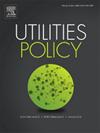级联社会风险:中国非典型电力系统故障的跨空间脆弱性分析
IF 4.4
3区 经济学
Q3 ENERGY & FUELS
引用次数: 0
摘要
非典型大规模电力故障(ALPF)在风险社会中变得越来越频繁,强调了减轻跨空间级联风险以减少损失和确保公共安全的必要性。本研究建立了跨空间脆弱性模型(CSVM)来分析ALPF风险。它将级联风险和脆弱性理论与领结模型相结合,形成了中国情景下三种ALPF情况的贝叶斯网络基础,包括夏季高温干旱、冬季寒潮和煤炭价格波动。分析模型从官方新闻、政策文本和专家意见来源中完成贝叶斯网络,有三个关键发现。首先,ALPF可能不成比例地影响经济稳定、社会稳定、公共卫生和安全,严重后果的概率与ALPF事件的可能性呈非线性相关。其次,对alpf的有效风险应对需要重点关注几个关键情景,如应急响应的延迟、过时的电网技术和对住宅用电量的限制。第三,工程和非工程措施应相结合,优先确保社会和生计系统的正常运作。与以往的研究不同,我们将重点放在ALPF事件的特异性上,更强调案例驱动的方法,从以往研究的工程和技术倾向转向综合维度。对风险的动态性质给予了更多的考虑。本文章由计算机程序翻译,如有差异,请以英文原文为准。
Cascading social risks: A cross-spatial vulnerability analysis of atypical power system failures in China
Atypical large-scale power failure (ALPF) has become more frequent within a risk society, highlighting the need to mitigate cross-spatial cascading risks in order to reduce losses and ensure public safety. This study develops a Cross-Spatial Vulnerability Model (CSVM) to analyse ALPF risks. It combines cascading risk and vulnerability theory with the bow-tie model, forming the basis of a Bayesian network for three ALPF cases in the China scenario, including summer heat and drought, winter cold waves, and coal price fluctuations. The analysis models complete Bayesian networks from official news, policy texts, and expert opinion sources, with three key findings. First, ALPFs can disproportionately impact economic stability, social stability, public health, and safety, with the probability of severe consequences being non-linearly related to the likelihood of ALPF events. Second, effective risk response to ALPFs requires focused attention on several key scenarios, such as delays in emergency response, outdated grid technologies, and restrictions on residential electricity consumption. Third, engineering and non-engineering measures should be integrated, with priority given to ensuring the proper functioning of social and livelihood systems. Unlike previous studies, we focus on the specificity of ALPF events, with a greater emphasis on a case-driven approach, shifting from the engineering and technical tendencies of previous studies to a comprehensive dimension. More consideration is given to the dynamic nature of risk.
求助全文
通过发布文献求助,成功后即可免费获取论文全文。
去求助
来源期刊

Utilities Policy
ENERGY & FUELS-ENVIRONMENTAL SCIENCES
CiteScore
6.80
自引率
10.00%
发文量
94
审稿时长
66 days
期刊介绍:
Utilities Policy is deliberately international, interdisciplinary, and intersectoral. Articles address utility trends and issues in both developed and developing economies. Authors and reviewers come from various disciplines, including economics, political science, sociology, law, finance, accounting, management, and engineering. Areas of focus include the utility and network industries providing essential electricity, natural gas, water and wastewater, solid waste, communications, broadband, postal, and public transportation services.
Utilities Policy invites submissions that apply various quantitative and qualitative methods. Contributions are welcome from both established and emerging scholars as well as accomplished practitioners. Interdisciplinary, comparative, and applied works are encouraged. Submissions to the journal should have a clear focus on governance, performance, and/or analysis of public utilities with an aim toward informing the policymaking process and providing recommendations as appropriate. Relevant topics and issues include but are not limited to industry structures and ownership, market design and dynamics, economic development, resource planning, system modeling, accounting and finance, infrastructure investment, supply and demand efficiency, strategic management and productivity, network operations and integration, supply chains, adaptation and flexibility, service-quality standards, benchmarking and metrics, benefit-cost analysis, behavior and incentives, pricing and demand response, economic and environmental regulation, regulatory performance and impact, restructuring and deregulation, and policy institutions.
 求助内容:
求助内容: 应助结果提醒方式:
应助结果提醒方式:


